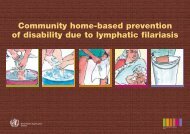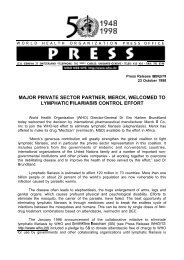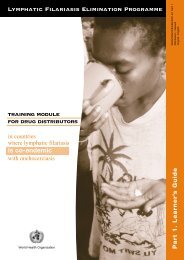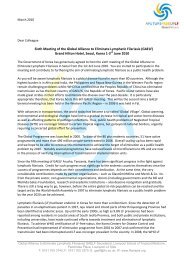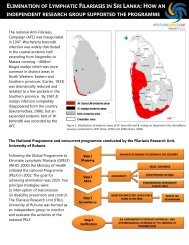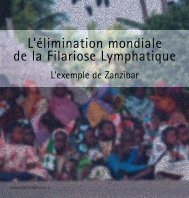Global Programme to Eliminate Lymphatic Filariasis ... - libdoc.who.int
Global Programme to Eliminate Lymphatic Filariasis ... - libdoc.who.int
Global Programme to Eliminate Lymphatic Filariasis ... - libdoc.who.int
You also want an ePaper? Increase the reach of your titles
YUMPU automatically turns print PDFs into web optimized ePapers that Google loves.
GUYANA63Endemicity statusEndemicNon-endemicUncertainAnnual Report on <strong>Lymphatic</strong> <strong>Filariasis</strong> 2003LF is a major public health problem in Guyana. Mappingwas completed in 2001. The estimated at-risk populationis 639 000 people — 90% of the entire population. Theproportion of infected population is 9.3%.The country is divided in<strong>to</strong> 10 administrative regions. Theregion was designated as the IU. Nine of the 10 regions(IUs) are considered endemic for LF. Surveys conductedin 2002 revealed that approximately 0.5% of the <strong>to</strong>tal populationhas lymphoedema and 0.1% hydrocele. Two fixedsentinel sites and two spot check sites were establishedin 2003. Baseline ICT prevalence was 35% in the sentinelsite of George<strong>to</strong>wn and 18% in that of New Amsterdam.The ministry of health authorities decided <strong>to</strong> adopt thediethylcarbamazine-fortified salt (DEC-fortified salt)treatment regimen and the importation of DEC-fortifiedsalt was therefore approved by the National Cabinet andthe Food and Drug Department in 2002. Importation ofthe DEC-fortified salt, which is supplied by three companies(from Cuba, Jamaica and Trinidad) commencedin June 2003. The supplies from Cuba and Trinidad andTobago were not guaranteed; only Jamaica has beenexporting fortified salt and some problems occurreddue <strong>to</strong> the change of staining of the product. The officialprogramme launch was in July 2003 and was limited <strong>to</strong>George<strong>to</strong>wn. It is expected <strong>to</strong> cover the entire countrywithin the next year. A moni<strong>to</strong>ring and evaluation planhas been developed <strong>to</strong> evaluate salt use at the householdlevel. Implementation of this plan will take place in 2004.A quality control system <strong>to</strong> moni<strong>to</strong>r the salt fortificationprocess was in place prior <strong>to</strong> the 2003 launch. Allimported salt is tested by the Food and Drug Departmentwith confirma<strong>to</strong>ry testing by CDC.Chapter 3 <strong>Programme</strong> implementationTable 3.13 Goal: <strong>to</strong> eliminate LF from Guyana by 2006Objectives• To implement DEC-fortified salt MDAregimen in conjunction with disabilitymanagement activities• To decrease suffering from, andworsening of, LF-related disability• To <strong>int</strong>egrate the LF elimination programmein<strong>to</strong> ongoing communityhealth worker activitiesStrategies• Establish salt association <strong>to</strong> strengthen private sec<strong>to</strong>r partnership• Promote and sustain population support through social marketing andmobilization• Establish disability clinics in all regions, in coordination with existingderma<strong>to</strong>logy/leprosy mobile clinics• Continue health worker training



